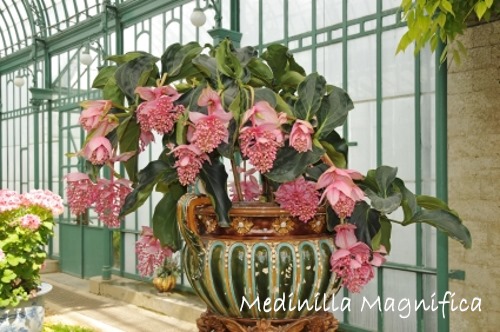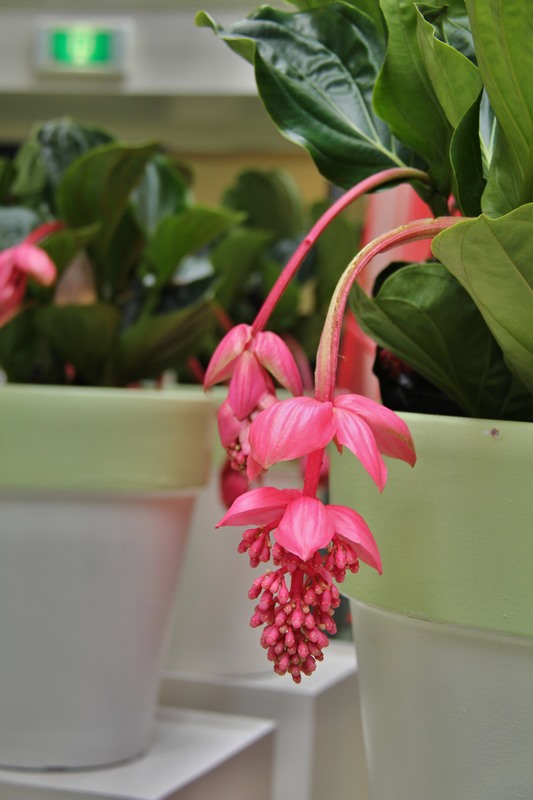Medinilla magnifica
Botanical Name: Medinilla magnifica
This tropical shrub bears drooping clusters of rosy pink flowers, giving it a common name of Rose Grape.
One of the most elegant flowering plants you can grow indoors, M. magnifica is every bit as magnificent as its name.
However, it's not easy to please unless you can provide the high humidity this tropical native craves. Use every means to increase the moisture in the air around it.

Get to Know Medinilla Magnifica
Pairs of thick, glossy green leaves cover the upright stems. The leaves get big -- up to 1 ft (30 cm) long -- and are deeply veined with wavy edges.
In spring and early summer, given enough light and humidity, you can expect long, pendulous flower stalks to grow from the tips of the branches.
The flower heads are spectacular. Clusters of small, pink flowers are carried beneath 2 or 3 tiers of pink bracts that grow to 4-inches (10 cm) long.
Did you know...
Medinilla is a genus in the Melastomaceae family that includes about 150 species. They're all natives of the tropics from southern Asia, western Africa and the Pacific islands.
Varieties with darker pink flowers are sometimes available. Medinilla magnifica 'Rubra' has darker pink flowers. 'Superba' has larger flowers that are dark pink.
Caring for Medinilla Magnifica Year-Round
Cut it back. After flowering, prune the plant back by as much as half to control its size.
Wondering whether to repot? Repotting is probably only needed every couple years. Put Medinilla magnifica in a big container. If you want to control its size, keep the plant in the same pot and top-dress it every year.
How to Top-Dress: Remove the top 2-3 inches of potting mix and replace with fresh mix every couple years. Take care not to harm any roots that may be near the surface.
Winter Care. Give this evergreen shrub a dry, cool rest in winter. It will tolerate a minimum of 60°F/16°C in winter. Cut back on water -- but don't allow the soil to dry out -- and stop fertilizing during this winter rest. Maintain high humidity with a cool-mist room humidifier. Added humidity also helps to prevent an invasion of spider mites that are attracted to dry conditions.
 Close-up of the pendulous blooms. Photo credit © Weronika Klimkova
Close-up of the pendulous blooms. Photo credit © Weronika KlimkovaMedinilla Magnifica Care Tips
Origin: Philippines
Height: Up to 4 ft (1.2 m)
Light: Bright, indirect light. Harsh, direct sunlight will scorch the leaves.
Water: Keep the soil evenly moist spring through fall. Water sparingly in winter, keeping the plant barely moist. Use a pot with drainage holes to prevent soggy potting medium.
Humidity: High humidity is a must. It's a good idea to use a humidity monitor near your plant, rather than guess. Indoor air can become extremely dry during the winter months without our noticing it. If the relative humidity drops below 60%, use a cool-mist room humidifier or set the plant on a tray of wet pebbles.
Temperature: Warm (70-75°F/21-24°C); slightly cooler in winter with a minimum temperature of 60°F/16°C.
Soil: Peat moss-based mix, such as African violet potting mix.
Fertilizer: Feed every 2 weeks spring through fall with a high-phosphorous fertilizer (such as 10-20-10) diluted to half-strength.
Propagation: Division or take cuttings in spring. Maintain warmth (70°F/21°C) for cuttings with a seedling heat mat.


